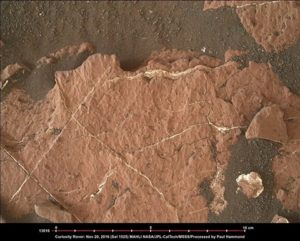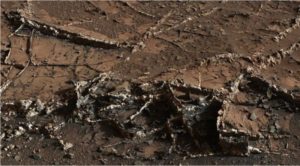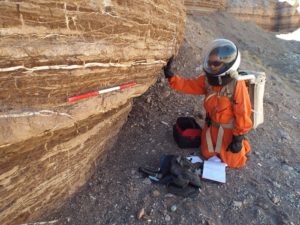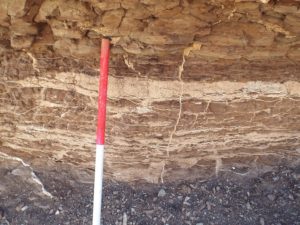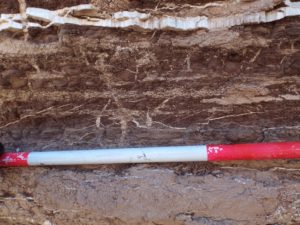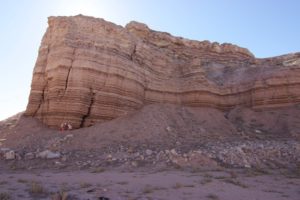Science Post – November 26th
Gypsum Astrobiology
By Crew Biologist Anushree Srivastava
On Earth, gypsum (CaSO4.2H2O) is deposited via evaporation of calcium and sulphate rich water. Gypsum is fragile, mostly translucent and occurs as thick, sedimentary evaporite beds. It is fairly common mineral on Earth and can be found around the salt lakes, hot springs, and veins of sulphate solution. Since it is relatively easily dissolved in the water gypsum is rarely found at the surface except in deserts. In hydrothermal systems, gypsum can be formed when anhydrite (CaSO4) is exposed to the near-surface groundwater. Buick & Dunlop in 1990 recorded ancient evaporitic environment of gypsum as old as Archaean (3.5 billion years old).
Several robotic missions to Mars, such as Omega instrument of ESA’s Mars Express Orbiter detected gypsum deposits on various locations on Mars in 2005 and then in 2013 Curiosity rover discovered the veins of gypsum in the fractured bedrocks in Gale crater, the location known as Yellowknife Bay. These occurrences of gypsum sediments in the crater is suggestive of the presence of the ancient lake in that location when Mars was warmer and wetter, which evaporated and the salty water precipitated in the form of gypsum.
Figure 1 a,b: Gypsum on Mars
Gypsum on Earth has been identified as home to endolithic communities in multiple extreme environments, it is therefore of great astrobiological interest. Culka and coworkers (2014) detected the carotenoid pigments from halophilic endolithic communities within stratified gypsum crusts using a miniaturized Raman spectrometer. Studies suggest that terrestrial halite/gypsum encrustations in the tidal regions are habitats of ‘endoevaporitic communities’ and these evaporitic environments were habitable even in the Archaean eon. Moreover, the Atacama Desert in Chile is the ideal Martian analogue as it is a hyperarid environment and the surface is hostile for any life to be able to survive. However, gypsum crystals in halite crusts host photosynthetic microbial life which might got encapsulated in the evaporite when this region desiccated in the ancient past. Therefore, for these reasons, gypsum is considered to be a potential target in the search for biosignatures in similar Martian evaporite deposits.
Gypsum deposits in the Utah Desert belong to the Jurassic and Cretaceous sediments that date back 200-100 million years old. As part of Mars 160 science goals, we intend to study these ancient gypsum sediments from astrobiological perspectives for the very first time here at Mars Desert Research Station. We intend to detect any signature of halophilic life inside the ancient gypsum which would be indicative of prolonged survival potential of these microbes. We have collected gypsum samples from Summerville Formation of Jurassic age. Summerville Formation is characterized by the alternating red-brown colour rippled sandstone and shale with mud cracks and white gypsum; to my amazement, white and pattern like coconut! In 1991, Caputo and Pryor described the Summerville deposition as deposited under “mud rich, restricted, evaporative, hypersaline conditions”. This formation is noted to be a tidal deposit of the Jurassic Epicontinental Sea. Thus, considering the antiquity of these deposits, our work on gypsum astrobiology will be significant to test if any trace of dormant or extinct life encased inside the fluid-inclusions of these crystals.
Figure 2 a, b, c, d: Gypsum veins of Summerville Formation.
Further Reading:
Allwood AC, Burch IW, Rouchy JM, Coleman M (2013) Morphological Biosignatures in Gypsum: Diverse Formation Processes of Messinian (∼6.0 Ma) Gypsum Stromatolites. Astrobiology. 9: 870-886.
Buick R, Dunlop J.S.R 1990 Evaporitic sediments of early Archean age from the Warrawoona Group, North-Pole, Western Australia. Sedimentology. 37: 247–277
Culka A, Osterrothová K, Hutchinson I, Ingley R, McHugh M, Oren A, Edwards HG, Jehlička J (2014) Detection of pigments of halophilic endoliths from gypsum: Raman portable instrument and European Space Agency’s prototype analysis. Philos Trans A Math Phys Eng Sci. Dec 13: 372




